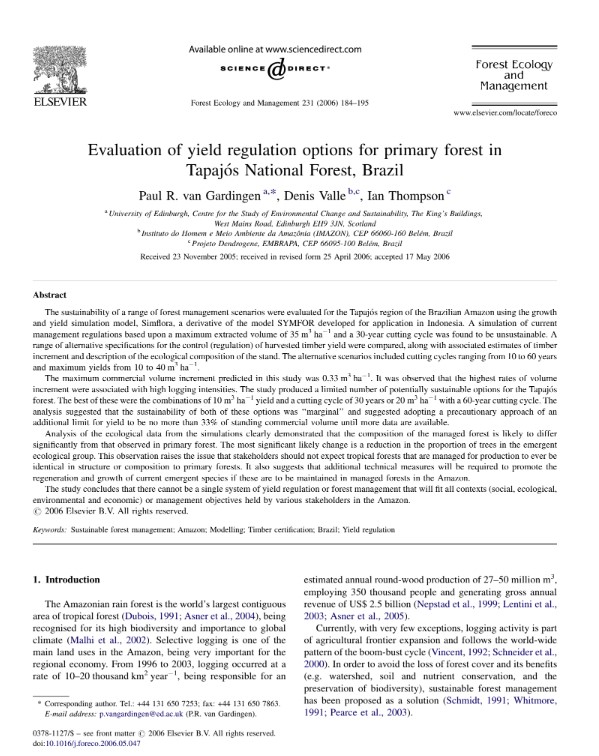

| Título | Evaluation of yield regulation options for primary forest in Tapajós National Forest, Brazil. |
| Autores | Paul R. van Gardingen Denis ValleIan Thompson |
| Ano de publicação | 2006 |
| DOI | https://doi.org/10.1016/j.foreco.2006.05.047 |
Vangardingen, P., Valle, D., & Thompson, I. 2006. Evaluation of yield regulation options for primary forest in Tapajós National Forest, Brazil. Forest Ecology and Management, 231(1-3), 184-195.
The sustainability of a range of forest management scenarios were evaluated for the Tapajós region of the Brazilian Amazon using the growth and yield simulation model, Simflora, a derivative of the model SYMFOR developed for application in Indonesia. A simulation of current management regulations based upon a maximum extracted volume of 35 m3 ha−1 and a 30-year cutting cycle was found to be unsustainable. A range of alternative specifications for the control (regulation) of harvested timber yield were compared, along with associated estimates of timber increment and description of the ecological composition of the stand. The alternative scenarios included cutting cycles ranging from 10 to 60 years and maximum yields from 10 to 40 m3 ha−1.
The maximum commercial volume increment predicted in this study was 0.33 m3 ha−1. It was observed that the highest rates of volume increment were associated with high logging intensities. The study produced a limited number of potentially sustainable options for the Tapajós forest. The best of these were the combinations of 10 m3 ha−1 yield and a cutting cycle of 30 years or 20 m3 ha−1 with a 60-year cutting cycle. The analysis suggested that the sustainability of both of these options was “marginal” and suggested adopting a precautionary approach of an additional limit for yield to be no more than 33% of standing commercial volume until more data are available.
Analysis of the ecological data from the simulations clearly demonstrated that the composition of the managed forest is likely to differ significantly from that observed in primary forest. The most significant likely change is a reduction in the proportion of trees in the emergent ecological group. This observation raises the issue that stakeholders should not expect tropical forests that are managed for production to ever be identical in structure or composition to primary forests. It also suggests that additional technical measures will be required to promote the regeneration and growth of current emergent species if these are to be maintained in managed forests in the Amazon.
The study concludes that there cannot be a single system of yield regulation or forest management that will fit all contexts (social, ecological, environmental and economic) or management objectives held by various stakeholders in the Amazon.
This post was published on 13 de junho de 2006
Título Índice de Progresso Social Brasil 2025 Autores Melissa Wilm Daniel Santos Beto Veríssimo Marcelo…
Amorim, L., Ferreira, R., Dias, M., Souza Jr., C., & Veríssimo, A. Sistema de Alerta…
Título Relatório Anual do Desmatamento no Brasil - RAD2024 Autores Carolina Del Lama Julia Shimbo…
Título Fatos da Amazônia 2025 Autores Daniel Santos Manuele Lima Agatha Vilhena Beto Veríssimo Caíque…
Amorim, L., Ferreira, R., Dias, M., Souza Jr., C., & Veríssimo, A. Sistema de Alerta…
Título A Vocação da Restauração Florestal na Amazônia com Base na Vegetação Secundária Autores Jayne…